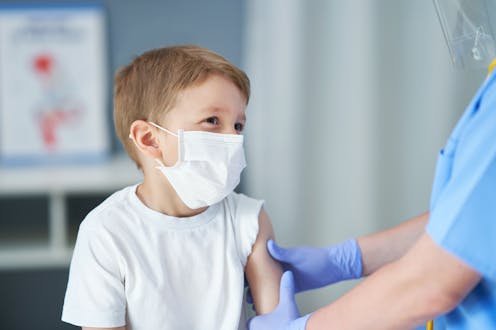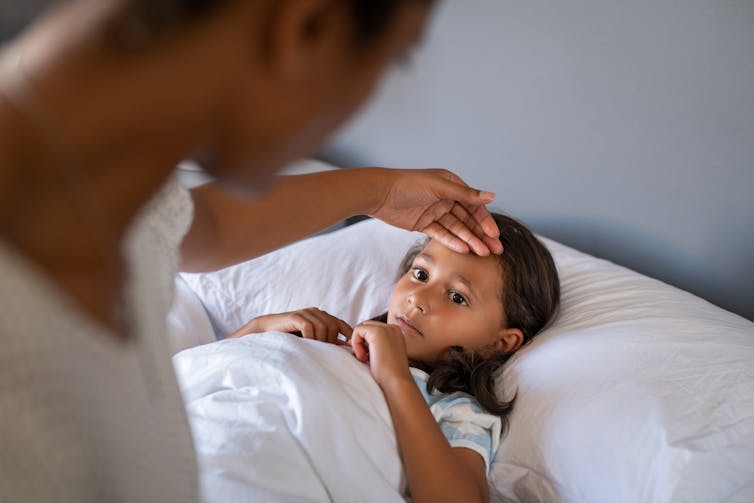
Pfizer’s COVID-19 vaccine became available for children aged five to 11 in the UK in April 2022. Those aged 12 and up had already been eligible since 2021.
But if you have a child aged under five, you might be wondering, when will they be able to be vaccinated against COVID-19? Children under five represent the only age group yet to have a COVID-19 vaccine approved for use. There could be a number of reasons for this, including the fact children don’t tend to be as seriously affected if they contract COVID-19, so other groups have possibly been prioritised.
But both Pfizer and Moderna have been testing their COVID-19 vaccines in this age group and, based on these results, it’s possible there will be one or more COVID-19 vaccines approved for young children in the coming months.

This article is part of Quarter Life, a series about issues affecting those of us in our twenties and thirties. From the challenges of beginning a career and taking care of our mental health, to the excitement of starting a family, adopting a pet or just making friends as an adult. The articles in this series explore the questions and bring answers as we navigate this turbulent period of life.
You may be interested in:
Long social distancing: how young adults’ habits have changed since COVID
My five-year-old is now eligible for a COVID vaccine – should I get them immunised?
Five tips for young people dealing with long COVID – from a GP
Pfizer/BioNTech has been trialling their vaccine in children aged six months up to five years. Children in this age group receive three doses of three micrograms each. For comparison, the vaccine schedule approved for five- to 11-year-olds consists of two doses of ten micrograms each, while older children and adults receive 30 micrograms per dose of the Pfizer vaccine.
In May 2022, Pfizer released results based on administering three doses to 1,678 young children. They reported the vaccine was well tolerated in this age group, with a safety profile similar to the placebo.
The three-dose regimen was introduced after initial studies on the two-dose regimen showed that the immune response wasn’t strong enough. The immune response is a separate, though related, measure to efficacy. It can be measured by determining the concentration of antibodies that neutralise infection, or through the cellular immune response, including the number of immune cells called T cells. Pfizer has reported that three doses generated a strong immune response.
Their results stated the vaccine had an efficacy of 80%, meaning those children who were vaccinated had an 80% lower risk of developing COVID-19 compared to the placebo group. The data was collected during a time when omicron was the main circulating variant.
While these results are encouraging, it’s important to note that they’re in the form of a press release from Pfizer with limited detail and have not yet been published in a peer-reviewed journal article.
Moderna has tested its vaccine in a similar age group as part of the KidCOVE study, which included roughly 2,500 children aged six months to two years, and 4,200 children aged two up to six. The regimen comprised two doses of 25 micrograms each – one-quarter of the dose given to adults.
In March 2022, also in a press release, Moderna reported two doses were able to induce neutralising antibodies without any serious adverse events. Vaccine efficacy in preventing COVID-19 in children six months to two years was 43.7%, and 37.5% in the two to six age group.
According to Moderna, efficacy could not be measured with respect to severe illness, hospitalisation or death, as none of these events occurred in the study. Pfizer’s press release doesn’t mention whether or not its trial measured these outcomes.
Moderna has reportedly applied to the relevant regulatory bodies in the US and the EU for emergency authorisation of its vaccine for this age group. Pfizer was similarly expected to request emergency authorisation in the US following the release of its results.
How important is COVID-19 vaccination for young children?
COVID-19 has generally been found to be milder in children compared to adults, with significantly lower mortality.
In a study of 203 children aged six days up to 18 years, who were infected before vaccination was available for any age group, 54.7% were asymptomatic. Symptomatic disease was found to be more likely in infants aged under one. While most of the cases were mild, of the 92 children who did develop symptoms in this study, 26% were admitted to hospital.
Another study found 401 out of 419 children with COVID-19 had mild or no symptoms.
However, children with COVID-19 can occasionally present with severe illness up to six to eight weeks afterwards – the rare complication referred to as “multi-system inflammatory syndrome”. The causes are not fully understood, although it may be related to altered levels of inflammatory markers. The condition is associated with myocarditis (inflammation of the heart muscle), vasculopathy (disease of the blood vessels), and can also be linked to hepatitis (inflammation of the liver).
Further, some children who contract COVID-19 will continue to experience symptoms after the infection has passed, known as long COVID. Studies on how commonly this occurs have reported mixed results.

Where to from here?
In the UK, COVID-19 vaccination rates are fairly low in the five to 12 age group. The data for England show recent uptake just above 8%, suggesting there’s a reluctance to have children vaccinated. It’s important we understand and address the source of this reluctance. Possible reasons may include concerns around the vaccine, or the perception that children are not severely affected by COVID-19.
While for the most part the latter is true, we know some children are affected more seriously. There is therefore a basis for vaccinating children even as young as six months to reduce the risks of infection.
Although there were no serious adverse events reported in Pfizer’s or Moderna’s trials, we have seen serious incidents such as myocarditis reported on occasion in older age groups. So it is possible that as more young children are vaccinated, we would see rare instances of serious side effects.
That said, the mRNA vaccines have a good safety profile. The fact that there could be a low risk of adverse events from the vaccine should not deter parents from vaccinating when compared with the risks of illness, hospitalisation and complications such as multi-system inflammatory syndrome due to the virus itself.
One Danish study found the incidence of multi-system inflammatory syndrome in unvaccinated children to be one in 3,400, compared with one in 9,900 in vaccinated children.
Vaccinating younger children could also limit community spread of COVID-19, although the extent to which children contribute to transmission of the virus has been subject to debate.
Before we can start vaccinating the youngest children, we will need to wait for peer-reviewed data to confirm safety and efficacy, and for approval from the relevant regulatory bodies. But we may see this fairly soon.
Tara Hurst does not work for, consult, own shares in or receive funding from any company or organisation that would benefit from this article, and has disclosed no relevant affiliations beyond their academic appointment.
This article was originally published on The Conversation. Read the original article.







